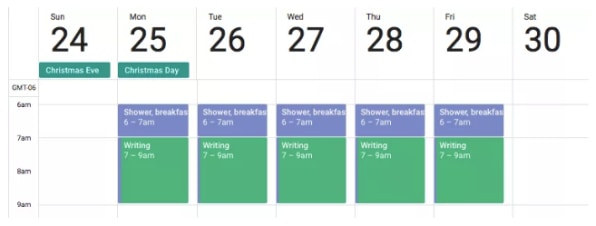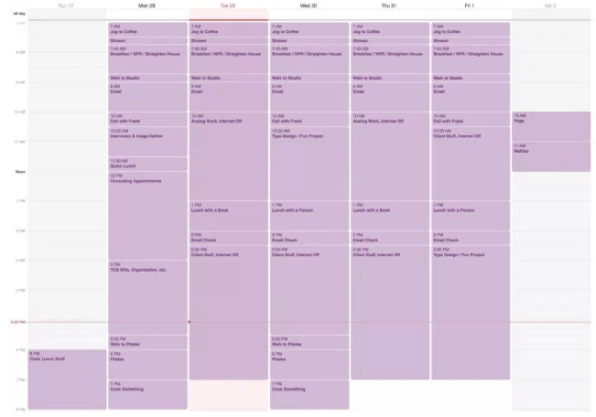What Is a 5 2 2 5 Work Schedule
When it comes to our daily schedule, most people fall into one of two camps:
-
- The over-scheduler: Their calendars look like a kindergartener's finger painting. Meetings overlap meetings while reminders for events, breaks, tasks, and more meetings are going off like it's New Year's Eve. Their days are determined from the moment they wake up to their evening routine.
- The minimalist: Also known as "The Dreamer." They've got one or two recurring events, but a whole lot of whitespace so they're "free" (at least on paper) for long stretches of work.
The problem is that both of these are terrible. For their own reasons.
Being over-scheduled leaves us no time for ourselves. The more "in control" we are of our calendar, the less control we feel like we have over our lives. Not to mention we're notoriously bad at knowing how long tasks take us to do. When your schedule is this jammed, even going 15 minutes over on your morning task will throw your whole day out of whack.
And the minimalist? Well, they're just living in la la land, aren't they? They've offloaded their schedule to some other format–most likely a to-do list, scheduling app, or series of angry emails asking "Where is this?"
Create "Time Bookends" For Your Day's Most Important Work
The most successful people consistently get their most important work done first.
Whether by "swallowing a frog" (i.e. getting your most difficult task out of the way so the rest of the day is a breeze) or blocking time for personal or meaningful work before anything else.
What they don't do, is start the day with distractions, emotional triggers, and stress (i.e. email, social media, and Slack).
Build recurring time into your daily schedule for your most important work before everything else. Not only are our energy levels naturally higher in the morning, but completing a meaningful task first thing has a domino effect that pushes you through the day.
There's tons of great examples of this, but one of my favorites comes from founder and academic Kevin Taylor, who sets recurring daily, blocks for his mornings:

As Taylor explains:
"If you're like most, you schedule what others demand of you first and only later look for empty slots in the calendar where you might 'fit in' what is important to you. (Good luck finding focus time in that type of 'reactively-designed' calendar.)
"Instead, flip the paradigm by scheduling what is important to you first."
Setting a recurring commitment to yourself first thing in the morning sets your day off with the right intention and ensures that no matter what else happens, you've done something meaningful in your day.
Another great way to do this is to schedule RescueTime FocusTime sessions to automatically start in the morning. This way, you won't be distracted by social media or other attention-seekers.
Related: How To Design Your Ideal Workday Based On Your Sleep Habits
Start The Day With A "Full" Plate
Taking the weekly template idea even further, you can create a template for your entire day, not just the morning.
Now, this isn't the same as the daily schedule of the overscheduler, whose day is filled with other people's priorities. But rather a way to ensure you protect time to do all the things you want to do each day.
One example is what designer Jessica Hische calls her "Ultraschedule":

This template is like a skeleton on which you build your week. For Hische, this meant keeping Monday as "Admin Day" for regular calls and meetings, while setting aside time on Wednesdays and Fridays for "Analog Work":
"There are scheduled times during which I can be fully immersed in email and for the rest of the day I'm forcing myself to ignore it. Most of all, there are scheduled blocks of time where my wifi will be off."
One of the best parts about this approach is that it helps you visualize your ideal work day–an important skill that few of us practice.
If how you picture yourself spending every day isn't lining up with how you're actually spending your time, then it might be time to step back and re-evaluate your priorities.
Set Your Availability To The Minimum You Can (10-15 minutes)
With your meaningful morning and daily skeleton schedule set, the next question is: How do you fit in the inevitable tasks, appointments, meetings, and responsibilities that creep up and throw your day out of whack?
An ideal schedule protects your time. So, putting processes in place that keep your time sacred are a good place to start.
For Facebook VP of Product, Fidji Simo, this means changing the default time for meetings to the minimum possible, as reported by First Round Review:
"Many people don't check in to figure out how much time should be realistically allotted to something. They just default to 30 minutes for a small conversation and 60 minutes for a larger conversation. This contributes to calendars looking like Swiss cheese."
Instead, Simo sets the minimum time for meetings at 10-15 minutes (Elon Musk famously breaks his entire day into 5 minute chunks), leaving the person booking to request more time if they feel they need it.
This makes both you and the meeting's organizer responsible for deciding how much time they really need. (Which is a great place to start when fixing our obsession with meetings.)
Simo also recommends setting buffers around your meeting times, as well as setting aside intentional open slots into your day for last-minute surprises. This way, you're not being naive about the distractions you're bound to face.
"I'm most focused when I set my own agenda versus when I let others set my agenda," she says.
Related: This Is How To Actually Work Smarter, Not Harder
Keep All Your Time Commitments In One Place
It might seem like a good idea to separate your personal and professional calendars, but this is just asking for trouble when commitments overlap.
Instead, bring all your commitments together on the same calendar so you know how much time you're actually working with. You can use color coding to differentiate between activities if you'd like.
You can think of your calendar as a big empty jar. Each task you add–whether personal or professional–fills up space. And while you might assign different levels of importance to tasks, your calendar doesn't. An hour is an hour no matter what you spend it on.
Your daily schedule keeps you honest. Set it up properly and you'll have a clear view of what needs to be done and any scheduling conflicts that are going to cause you headaches.
A version of this article originally appeared on RescueTime and is adapted with permission.
What Is a 5 2 2 5 Work Schedule
Source: https://www.fastcompany.com/40526810/how-you-can-create-a-schedule-that-really-works-for-you